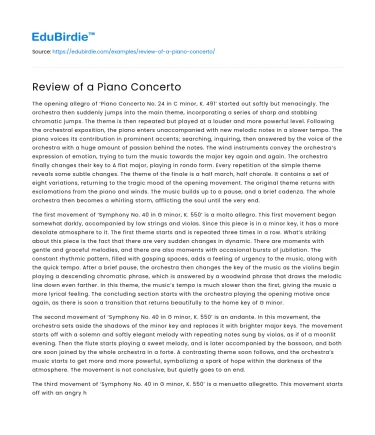The opening allegro of ‘Piano Concerto No. 24 in C minor, K. 491’ started out softly but menacingly. The orchestra then suddenly jumps into the main theme, incorporating a series of sharp and stabbing chromatic jumps. The theme is then repeated but played at a louder and more powerful level. Following the orchestral exposition, the piano enters unaccompanied with new melodic notes in a slower tempo. The piano voices its contribution in prominent accents; searching, inquiring, then answered by the voice of the orchestra with a huge amount of passion behind the notes. The wind instruments convey the orchestra’s expression of emotion, trying to turn the music towards the major key again and again. The orchestra finally changes their key to A flat major, playing in rondo form. Every repetition of the simple theme reveals some subtle changes. The theme of the finale is a half march, half chorale. It contains a set of eight variations, returning to the tragic mood of the opening movement. The original theme returns with exclamations from the piano and winds. The music builds up to a pause, and a brief cadenza. The whole orchestra then becomes a whirling storm, afflicting the soul until the very end.
The first movement of ‘Symphony No. 40 in G minor, K. 550’ is a molto allegro. This first movement began somewhat darkly, accompanied by low strings and violas. Since this piece is in a minor key, it has a more desolate atmosphere to it. The first theme starts and is repeated three times in a row. What’s striking about this piece is the fact that there are very sudden changes in dynamic. There are moments with gentle and graceful melodies, and there are also moments with occasional bursts of jubilation. The constant rhythmic pattern, filled with gasping spaces, adds a feeling of urgency to the music, along with the quick tempo. After a brief pause, the orchestra then changes the key of the music as the violins begin playing a descending chromatic phrase, which is answered by a woodwind phrase that draws the melodic line down even farther. In this theme, the music’s tempo is much slower than the first, giving the music a more lyrical feeling. The concluding section starts with the orchestra playing the opening motive once again, as there is soon a transition that returns beautifully to the home key of G minor.
Save your time!
We can take care of your essay
- Proper editing and formatting
- Free revision, title page, and bibliography
- Flexible prices and money-back guarantee
The second movement of ‘Symphony No. 40 in G minor, K. 550’ is an andante. In this movement, the orchestra sets aside the shadows of the minor key and replaces it with brighter major keys. The movement starts off with a solemn and softly elegant melody with repeating notes sung by violas, as if of a moonlit evening. Then the flute starts playing a sweet melody, and is later accompanied by the bassoon, and both are soon joined by the whole orchestra in a forte. A contrasting theme soon follows, and the orchestra’s music starts to get more and more powerful, symbolizing a spark of hope within the darkness of the atmosphere. The movement is not conclusive, but quietly goes to an end.
The third movement of ‘Symphony No. 40 in G minor, K. 550’ is a menuetto allegretto. This movement starts off with an angry hemiola rhythm and offers darkness as well as light. An unusual feeling of brusqueness takes over the atmosphere, separating this dance from its royal, dignified ancestors. There are dark passages that are strongly assertive, but there are also light ones that are sweeter. The trio then plays in a cheerful G major timbre and presents a lyrical release, but the peacefulness is only temporary. G minor returns once again and proclaims its vigor and tense atmosphere in the da capo, the repetition of the first section.
The last and final movement of ‘Symphony No. 40 in G minor, K. 550’ is the finale: allegro assai. The finale has quite a fierce and explosive nature and opens with a bouncing triadic theme, outlining a simple chord. Hurried motifs from violins break its orderly nature, and soon enough the orchestra adds to the frenzy. The second theme makes an appearance from the violins and winds, offering lyrical contrast, but is briskly conquered by a violent development. Mozart’s complex writing and polyphonic textures sways the theme back and forth in an entwining and jerky pattern. There is then a brief pause, giving us a breath right before the recapitulation proceeds. ‘Symphony No. 40’ closes as it began, with a feeling of urgency and turmoil. The orchestra brings the movement, the symphony all in all, to an exciting and vigorous end.
I think that the information that I learned during this course helped me a lot while listening to the concert as well as writing about it. I knew what musical terminology to use that perfectly described and expressed what I heard during the concert, and I also knew what to listen for thanks to the listening journals.
In general, the concert was remarkably inspiring and majestic at the same time. Impressive transitions and rich music precisely reflected the notable characteristics of the style of the music. I was truly captured by all of the performers who managed to catch every single meaning, intonation, and word of the compositions. I was also greatly amazed at their capability to shift between different moods and tempos so quickly. The complimenting harmonies made me feel relaxed and cheerful, while the clashing harmonies made me feel turmoil and anxious. The concert as a whole was full of life as every instrument performed in consonance with the rest, not too loud nor too soft, just the perfect mix.






 Stuck on your essay?
Stuck on your essay?

